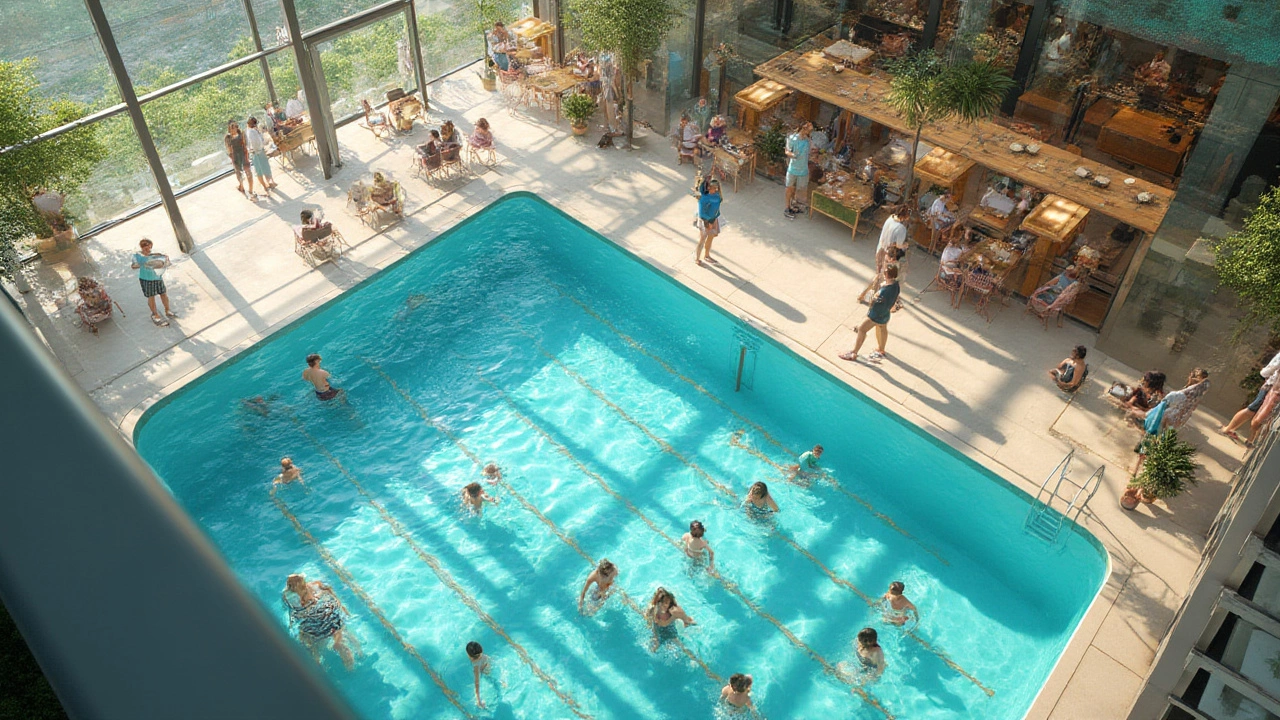Picture this: You’re chilling by your apartment pool, soaking up the sun, but only a few neighbors can join. The gate keeps outsiders out, but everyone who pays rent can come in. Ever stopped to wonder what kind of good that pool actually is? It’s not quite public, but it’s not strictly private either. This strange middle ground has a name—club goods—and the way they work can tell us a lot about how communities share, restrict, and enjoy resources.
What Makes a Good a Club Good?
Most people throw around words like “public good” or “private good” without giving much thought to all the gray areas in between. But the economic world is full of hybrids, and club goods are the classic in-betweener. A club good is something you have to pay or qualify for to use (like membership dues or residency), but once you get your ticket, you share it with others in the group. It's not unlimited, but it's more open than a private tennis court that's just for one family.
Let’s break down the key features that set club goods apart:
- Excludability: Not just anyone can use them. There’s usually a lock, membership card, digital code, or even just a fee separating the “in crowd” from everyone else. Think exclusive gyms, streaming platforms, or residents-only utilities.
- Non-rivalrous (up to a point): You using the good doesn’t stop others from using it... unless there’s overcrowding. A country club’s golf course can handle hundreds of members, but past a certain point, it gets messy—think of a packed swimming pool at summer’s peak.
Suddenly, a lot of everyday things start to look like club goods. Your neighborhood Wi-Fi? Boom, club good. Costco warehouse with that strict ID check at the door? Another club good. Even parking garages reserved for residents of an apartment complex fall right into this category.
Here’s a quick way to visualize the categories of goods and where club goods fit in. Check out this table:
| Type of Good | Excludable? | Rivalrous? | Example |
|---|---|---|---|
| Private Good | Yes | Yes | Sandwich, car |
| Public Good | No | No | National defense, street lights |
| Club Good | Yes | No (until crowded) | Gym, streaming service, toll road |
| Common Resource | No | Yes | Fishing grounds, free parking spaces |
This isn’t just some academic curiosity. The way people manage club goods shapes everything from city planning to how communities offer support. They’re everywhere: think about gyms with keycard entry, private roads that only neighborhood residents can use, or even the ultra-exclusive Soho House where creatives rub shoulders if—and only if—they’ve paid the hefty fee. According to a 2023 report from the American Economics Association, club goods make up a sizable chunk of local recreation services—up to 18% in some major cities.
So the next time you're asked for proof of membership at the community garden or confronted with a turnstile blocking entry to a members-only dog park, remember: you’re bumping up against a club good.

Real-World Club Good Examples You Probably Use
Club goods aren’t some rare quirk. When you actually look around your daily routine, they crop up everywhere—at home, online, even in your leisure time. Still feeling unsure what falls into this bucket? Time to get specific.
- Streaming Services: Think Netflix, Disney+, or Spotify. You pay a monthly fee, and after that, your usage doesn’t affect others... unless their servers collapse or content gets pulled thanks to licensing drama. These giants have turned entertainment into a club good, available for anyone with a password and their name on the payment info.
- Private Pools and Parks: Living in a gated community or condo complex with a pool or playground? Only residents—or their guests—can get in. Your splash doesn’t mess with your neighbor’s, but the experience definitely gets worse when everyone shows up on a July weekend. That’s the classic club good tradeoff.
- Member Gyms: Sure, a public park’s pull-up bars are free for everybody, but a 24-hour gym like Planet Fitness charges membership. The more users in peak hours, the more crowded, and the less fun it is. Hence why many gyms cap memberships or add more locations.
- Book Clubs or Wine Clubs: Less obvious but still spot-on. You pay fees, sometimes get access to a clubhouse or discounts, and you share resources with members. The membership means exclusivity, but if they get too popular, they can lose that close-knit feeling.
- Residents-Only Parking: If you live in a busy city, you’ve seen those reserved spots. Everyone with a permit can use them, but nobody else is allowed. It works right up until there are more cars than slots—another club good tightrope.
- Community Managed Broadband: In some neighborhoods, residents pool funds for high-speed internet, cheaper and faster than any outside option. The bandwidth is a shared club good: pay up, get access, but hope nobody starts gaming marathons during your peak work hours.
What’s fascinating is how club goods can encourage involvement and set clear boundaries. By restricting access, clubs can make the experience better for members, reinvest in facilities, or even fund specific projects (like exclusive summer events for residents). City planners in 2024 reported a 27% uptick in neighborhood-managed club goods, mostly fitness areas and green spaces. Membership models have become so popular that even libraries—previously bastions of public goods—are now offering "exclusive" services like private study rooms or members-only digital collections.
But these goods have a flip side. Managing boundaries isn’t always smooth. Limits on membership can trigger fights (think about the drama when your HOA debates how many pool passes to issue), and overcrowding—hello, jam-packed commuter trains or overloaded streaming servers—can make the whole thing frustrating. There’s a delicate dance in balancing enough members to pay the bills, but not so many the experience gets ruined.

Making the Most of Club Goods in Your Community
So how do you turn club goods into a win for everyone instead of an endless fight over pool passes? It starts with smart management, clear rules, and a healthy understanding of what makes people tick. If you’re in charge—maybe on a condo board, a resident association, or even a hobby group—there are ways to keep these shared resources running smoothly.
- Define clear access rules. Ambiguity causes headaches. Post the rules, spell out who gets in and when, and don’t be shy about turning away freeloaders. HOA meeting minutes from Miami in 2024 showed pools with well-communicated access rules had 40% fewer complaints about overcrowding.
- Limit numbers when necessary. It’s tough, but sometimes you have to cap membership. Whether it’s selling a limited number of guest passes or timing pool hours, setting limits preserves everybody’s enjoyment.
- Invest in maintenance and upgrades. You can’t just build a club good and ignore it. Regular cleaning, updating equipment, and listening to members pays dividends. In a 2023 UK survey, 68% of gym members said improvements to facilities kept them renewing their contracts.
- Foster a sense of ownership. When people feel they belong, they’re less likely to abuse resources and more likely to pitch in. Community gardens that scheduled group workdays saw less vandalism and healthier crops than ones where members never met. Encourage feedback, hold events, or ask members to help set guidelines.
- Use technology to manage demand. Online booking apps for amenities (like tennis courts) can smooth out peak crunch times. Sensors or smart locks can keep usage fair and transparent. Even streaming giants use algorithms to prevent too much crowding on popular content (shared logins beware!).
There isn’t a one-size-fits-all blueprint, but some communities have found clever ways to tailor their club goods. In Cambridge, Massachusetts, an apartment management company rolled out tiered memberships for gym facilities—basic access included, but premium got you after-hours entry and free guest passes. Their occupancy surveys found that this reduced peak hour crowding by 22% in just one season.
Want to start your own club good? Start small, gather interested members, and establish boundaries and expectations early. If pooling resources, set up a simple payment method and plan recurring check-ins to keep things on track. For inspiration, check what local groups are doing: fitness collectives, book exchanges, community tool sheds where neighbors can borrow power drills, or even group subscriptions for things like learning platforms.
Remember, the power of a club good is in its balance—exclusive enough to make membership feel worthwhile, but open enough for everyone to benefit. Once you get the hang of it, managing or joining these clubs can boost your daily life and build strong community ties. Keep your eyes open: chances are you’re already part of more club goods than you ever realized, unlocking little pockets of shared value all over your day-to-day routine.
